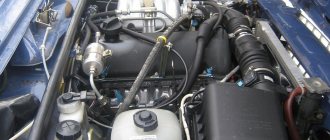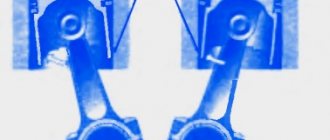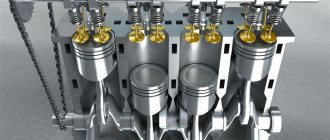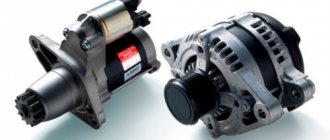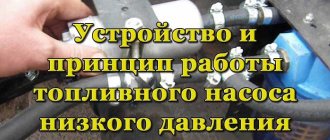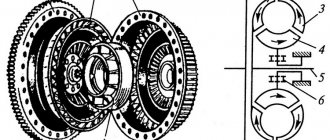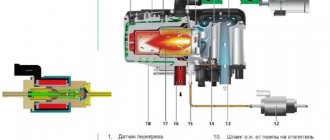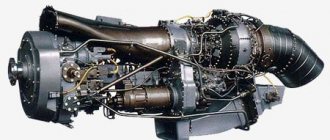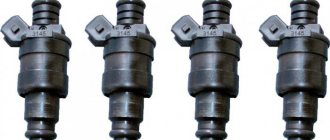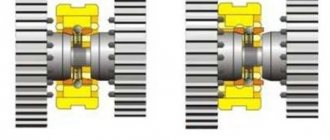General structure and operation of the engine
The internal combustion engine (ICE) is the most common type of passenger car engine.
The operation of this type of engine is based on the property of gases to expand when heated. The source of heat in the engine is a mixture of fuel and air (combustible mixture). There are two types of internal combustion engines: gasoline and diesel. In a gasoline engine, the combustible mixture (gasoline with air) is ignited inside the cylinder from a spark formed at spark plug 3 (Fig. 3). In a diesel engine, the combustible mixture (diesel fuel with air) is ignited by compression, and spark plugs are not used. On both types of engines, the pressure of the combustible gas mixture formed during combustion increases and is transmitted to the piston 7. The piston moves down and through the connecting rod 8 acts on the crankshaft 11, forcing it to rotate. To smooth out jerks and more uniform rotation of the crankshaft, a massive flywheel 9 is installed at its end.
Fig.3. Single cylinder engine diagram.
Let's consider the basic concepts of internal combustion engines and the principle of its operation.
Each cylinder 2 (Fig. 4) has a piston 1. Its uppermost position is called top dead center (TDC), its lowest position is called bottom dead center (BDC). The distance traveled by the piston from one dead center to the other is called the stroke of the piston. In one stroke of the piston, the crankshaft will rotate half a revolution.
Fig.4. Cylinder diagram
The combustion (compression) chamber is the space between the cylinder head and the piston when it is at TDC.
The cylinder displacement is the space vacated by the piston when it moves from TDC to BDC.
Engine displacement is the displacement of all engine cylinders. It is expressed in liters, which is why it is often called engine displacement.
The total volume of the cylinder is the sum of the volume of the combustion chamber and the working volume of the cylinder.
The compression ratio shows how many times the total volume of the cylinder is greater than the volume of the combustion chamber. The compression ratio for a gasoline engine is 8.10, for an diesel engine it is 20.30.
Compression should be distinguished from compression ratio.
Compression - this pressure in the cylinder at the end of the compression stroke characterizes the technical condition (degree of wear) of the engine. If the compression is greater than or numerically equal to the compression ratio, the engine condition can be considered normal.
Engine power is a quantity that shows how much work the engine does per unit time. Power is measured in kilowatts (kW) or horsepower (hp), with one horsepower approximately equal to 0.74 kW.
The engine torque is numerically equal to the product of the force acting on the piston during the expansion of gases in the cylinder and the arm of its action (the radius of the crank is the distance from the axis of the main journal to the axis of the connecting rod journal of the crankshaft). Torque determines the traction force on the wheels of a car: the greater the torque, the better the acceleration dynamics of the car.
Maximum power and torque are developed by the engine at certain crankshaft speeds (indicated in the technical specifications of each car).
Stroke is a process (part of the work cycle) that occurs in a cylinder during one stroke of the piston. An engine whose operating cycle occurs in four piston strokes is called four-stroke, regardless of the number of cylinders.
Operating cycle of a four-stroke carburetor engine. It flows in one cylinder in the following sequence (Fig. 5):
Fig.5. Duty cycle of a four-stroke engine
Fig.6. Four-cylinder engine operation diagram
1st stroke - intake. When piston 3 moves downward, a vacuum is formed in the cylinder, under the influence of which a combustible mixture (a mixture of fuel and air) enters the cylinder from the power system through the open inlet valve 1. Together with the residual gases in the cylinder, the combustible mixture forms a working mixture and occupies the entire volume of the cylinder;
2nd stroke - compression. The piston moves upward under the action of the crankshaft and connecting rod. Both valves are closed and the working mixture is compressed to the volume of the combustion chamber;
3rd stroke - power stroke, or expansion. At the end of the compression stroke, an electric spark occurs between the electrodes of the spark plug, which ignites the working mixture (in a diesel engine, the working mixture self-ignites). Under the pressure of expanding gases, the piston moves down and through the connecting rod causes the crankshaft to rotate;
4th measure - release. The piston moves upward, and exhaust gases exit the cylinder through the opened exhaust valve 4.
During the subsequent downward stroke of the piston, the cylinder is again filled with the working mixture, and the cycle is repeated.
Typically, an engine has several cylinders. Domestic cars usually have four-cylinder engines (on Oka cars there is a two-cylinder engine). In multi-cylinder engines, the cylinder strokes follow each other in a certain sequence. The alternation of working strokes or strokes of the same name in the cylinders of multi-cylinder engines in a certain sequence is called the order of operation of the engine cylinders. The cylinder order in a four-cylinder engine is most often I -3-4-2 or less commonly I -2-4-3, where the numbers correspond to the cylinder numbers starting from the front of the engine. Scheme in Fig. 6 characterizes the strokes occurring in the cylinders during the first half-turn of the crankshaft. The operating procedure of the engine must be known for the correct connection of high-voltage wires to the spark plugs when setting the ignition timing and for the sequence of adjusting the thermal clearances in the valves.
In fact, any real engine is much more complex than the simplified circuit shown in Fig. 3. Let's consider typical engine design elements and the principles of their operation.
The operating cycle of an internal combustion engine (ICE) is a series of processes that produce a portion of force (power) acting on the engine crankshaft. The work cycle consists of:
- filling the cylinder with the fuel mixture;
- its compression;
- ignition of the mixture;
- expansion of gases and cleaning the cylinder from them.
Operating principle of a four-stroke engine
A four-stroke engine is a piston engine in which one working cycle consists of four strokes. They have the following names:
In one cycle, the piston moves from TDC to BDC and back twice, and the crankshaft rotates two full revolutions. The events that occur during this time in the engine have a clearly defined sequence.
Inlet. The piston moves down to BDC. A vacuum is formed under it, due to which fuel mixed with air is drawn through the open intake valve plate from the intake manifold into the cylinder. The piston passes bottom dead center, after which the intake valve closes the intake manifold.
Compression stroke. The piston continues to move upward and compresses the air mixture.
At top dead center above the piston, the combustible mixture is ignited. When burned, it causes a significant increase in pressure on the piston. The power stroke begins. Under the influence of the pressure of the combustion gases, the piston again moves to BDC, while performing useful work.
After the piston passes BDC, the exhaust valve poppet opens. The piston, moving towards TDC, pushes exhaust gases into the exhaust manifold. This is the release stroke.
Then the intake stroke begins again and so on endlessly.
Types of motors
There are three types of engines found in vehicles:
- piston
- rotary piston
- gas turbine
The first version of motors is very popular. Some car models are equipped with four-stroke piston engines. This popularity is due to the fact that such units are cheaper, light in weight and suitable for use in almost all machines, regardless of production.
In simple terms, a car engine is a special mechanism that can change heat energy, turning it into mechanical energy, which makes it possible to ensure the operation of many structural elements of the car, as well as its systems.
It is not difficult to study the principle of operation of the motor. For example, piston internal combustion engines are divided into two- and four-stroke units. Four-stroke engines are called because in one operating cycle of the element the piston moves four times (stroke). More information about what bars are is written below.
Motor device
Before understanding the principle of operation, you should first understand how the power unit is structured and what is included in its design. Since piston ones are considered the most in demand, just such a device will be considered. The main details include:
- Cylinders forming a separate block
- Timing block head
- crank mechanism
The latter drives the crankshaft, causing it to rotate. The mechanism transmits to the shaft the energy received from the moving piston, which changes its position in several strokes. The movement of the piston is controlled by the heat energy resulting from the combustion of fuel.
It is impossible to imagine and organize the movement of a power unit without the mechanisms installed in it. For example, the timing belt changes the position of the valves, due to which it is possible to ensure a regular supply of fuel by admitting and releasing certain compounds. The system for the entry of new gases and the exit of exhaust gases has been established.
Carburetor and injection engines.
The preparation of the combustible mixture in carburetor engines occurs in a special device - a carburetor, in which the process of mixing fuel with the air flow is carried out due to artificial convection created by the aerodynamic forces of the air flow sucked in by the engine.
In injection engines, the mixture formation process is organized differently. Fuel is injected into the air flow through special nozzles. The fuel supply is metered by an electronic control unit, or (in older cars) by a mechanical system.
The first injection engines appeared in 1997. Their introduction was facilitated by the OMC Corporation, which released an engine designed using FICHT technology. A key factor in this technology was the use of special injectors, which allowed fuel to be injected directly into the combustion chamber. This revolutionary solution, coupled with the use of a modern on-board computer, made it possible to accurately dose fuel when moving the piston. Pure oil, without fuel impurities, is injected into the crankshaft cavity. Thanks to new technology, the designers managed to invent a two-stroke engine that was not inferior in efficiency to a carburetor four-stroke engine, and was also compact and lightweight.
Due to new emission standards, car manufacturers had to switch from classic carburetor engines to injection engines, and also install modern exhaust gas converters. For the catalyst to function, a constant composition of the exhaust gas is required, which is maintained by the fuel injection system. An essential component of the catalyst is an oxygen content sensor, thanks to which the exact ratio of oxygen, under-oxidized fuel combustion products and nitrogen oxides that the catalyst can neutralize is monitored.
If you decide to switch from a gasoline engine to gas equipment in your car, then you need to purchase all the necessary spare parts. Automotive propane gas reducers, as well as much more, can be purchased at an affordable price on this resource.
ICE duty cycle
The main cycle of the motor involves the execution of four main strokes. They are what will be discussed further in the text.
First stroke: intake
The initial one is the movement of the cams, which are part of the camshaft structure. They change their influence on the intake valve, forcing it to open.
Next, following the opened valve, the piston moves. The part gradually moves from the highest position to the lowest position. Due to the decrease in space by the piston, the air inside the cylinder becomes more rarefied, making it possible for the prepared working mixture to flow.
After this, the piston begins to act on the crankshaft through the connecting rod, as a result of which the shaft rotates 180 degrees. The piston itself has already reached its critical lower position, and at this moment the second stroke begins.
Second stroke: compression
It involves further compression of the mixture inside the cylinder. The intake valve closes and the piston changes direction, moving upward. Due to the decrease in space, the air begins to compress, and the working mixture begins to heat up. When the second stroke comes to an end, the ignition system comes into action. Its main purpose is to supply a charge of electricity to the spark plug to create a spark. It is this spark that ignites the compressed mixture of fuel and air, causing it to ignite.
It is also worth considering how the fuel in a diesel internal combustion engine is ignited. As soon as compression is completed, finely atomized diesel fuel begins to flow through the nozzle into the chamber. Subsequently, the flammable substance is mixed with the air inside, causing ignition.
As for a carburetor engine with standard fuel, on the second stroke the crankshaft has time to make a full revolution.
Third stroke: power stroke
The third stroke is called the power stroke. The gases remaining after the combustion of the mixture begin to push the piston, moving it down. The energy received by the part is transferred to the crankshaft, and it turns again, but this time by half a revolution.
Bar four: release
The fourth stroke is the release of the remaining gases. When the stroke begins, the cam changes position, this time the exhaust valve, opening it. This helps the piston begin to move upward, as a result of which exhaust gases begin to exit the cylinder.
It is interesting that on modern vehicle models, internal combustion engines are equipped not with one cylinder, but with several. Thanks to their coordinated work, better performance of the engine and machine systems is ensured. In this case, different strokes are performed simultaneously in each cylinder. So, for example, in one cylinder the working stroke is in full swing, and in the second the crankshaft is just making a revolution. A similar design also:
- eliminates unnecessary vibrations;
- balances the forces that act on the crankshaft;
- organizes smooth operation of the motor.
Due to their compactness, engines with several cylinders are made not in-line, but V-shaped. There is also a form of boxer engine that is often found on vehicles manufactured by Subaru. This solution saves a lot of space under the hood.
Two-stroke engine - operating features
If we consider a two-stroke engine, it should be noted that gas fuel exchange occurs when the piston is near the lower limit point (dead point), somewhat short of reaching it. Exhaust gases begin to be removed from the cylinder when their volume changes over a short period of time. Cleaning the cylinder in a classic two-stroke engine is done by blowing air through the compressor.
During purging, the air is partially removed and the exhaust gases are released using exhaust ports before they are closed by the piston. After this, the compression process begins, proceeding as in a conventional four-stroke engine. When the piston moves from bottom to top, the purge windows are blocked, after which air from the compressor is no longer supplied to the cylinder.
How does a two-stroke engine work?
It was mentioned above that piston engines are divided into both 4-stroke and 2-stroke. The operating principle of the latter is slightly different from what was described earlier. And the design of such a unit itself is much simpler than the previous design. In a two-stroke unit there are only two windows in the cylinder - inlet and outlet. The second is located slightly above the first, and what it is for will now be explained.
At the beginning of the first stroke, the piston, which previously blocked the inlet port, begins to move upward, as a result of which it blocks the fuel inlet port. At the same time, the piston continues to descend, which leads to compression of the working mixture. As soon as the part reaches the desired position, the first spark is formed on the candle, and the created mixture is immediately ignited, igniting. The inlet window is already opening at this point. It passes the next portion of fuel and air, continuing the operation of the mechanism.
The beginning of the second stroke is characterized by a change in the direction of movement of the piston - it begins to move downward. It is acted upon by gases that tend to expand the available space. The piston moves, opening the inlet window, and the gases remaining after combustion of the mixture escape, allowing a new portion of fuel inside.
Some of the working mixture also leaves the cylinder through the open exhaust valve. Therefore, it becomes clear why two-stroke engines require so much fuel.
Advantages and disadvantages
The advantage of two-stroke piston units is the achievement of high power with a small displacement when compared with four-stroke units. However, the car owner will suffer from impressive fuel consumption, which is why the idea of changing the unit will soon arise in his head.
Also, the advantages of two-stroke internal combustion engines include a simple design, clear and uniform operation, low weight and compact size. The disadvantages include dirty exhaust, a lack of various systems, as well as rapid wear of structural parts. Quite often, owners of cars with such an engine complain about overheating of the unit and its breakdown.
Performance in comparison
Comparing a two-stroke engine and a four-stroke engine, the difference between them can be seen not only in the design, but also in the performance characteristics. You can compare them based on the following indicators:
- liter capacity;
- specific power;
- efficiency;
- environmental friendliness;
- noisiness;
- work resource;
- ease of maintenance;
- weight;
- price.
Liter is the power removed from a liter of cylinder volume. Theoretically, it should be twice as large for a two-stroke. However, in reality this figure is 1.5−1.8. This is due to incomplete use of the working stroke of gases, energy consumption for purging, incomplete combustion and fuel losses.
Specific power is the ratio of motor power to its weight. It is also higher for two-strokes. They require a less heavy flywheel and do not require additional systems (gas distribution and lubrication) that make the structure heavier. Their efficiency is also higher.
Efficiency (fuel consumption per unit of power) is higher for four-stroke engines. Two-stroke engines waste some of the fuel when the cylinder is purged.
The environmental friendliness of two-stroke engines is lower, again due to the loss of unburned fuel and oil. You can verify this using the example of a two-stroke outboard motor. It always leaves a thin film of unburnt fuel on the water.
The noise is higher with two-stroke engines. This is due to the fact that the exhaust gases escape from the cylinder at high speed.
The service life is higher for four-stroke engines. A separate lubrication system and lower engine speed have a positive effect on its service life.
It is certainly easier to maintain two-stroke engines due to fewer auxiliary systems. Four-stroke models have more weight. Two strokes are cheaper.
In some mechanisms, the use of two-stroke engines is unambiguous. These are, for example, chainsaws. High power density, low weight and simplicity make it an absolute favorite here.
Two-stroke engines are also used in motorcycles, boat engines, lawn mowers, scooters, and aircraft modeling. In most homemade machines and mechanisms, craftsmen also use a two-stroke engine.
